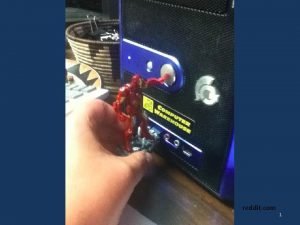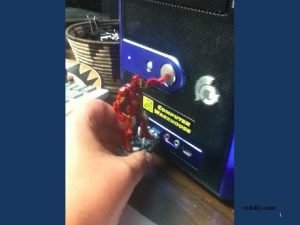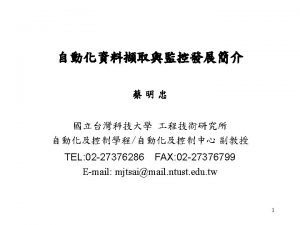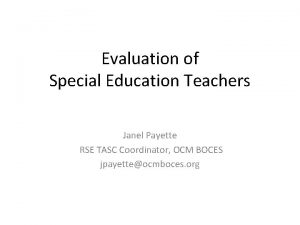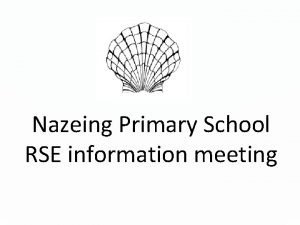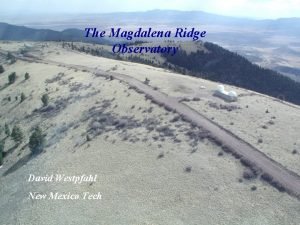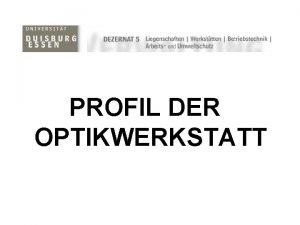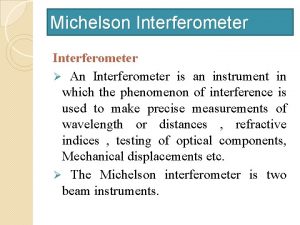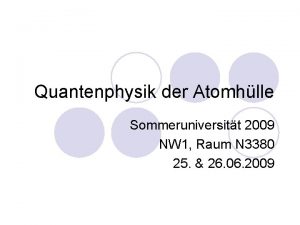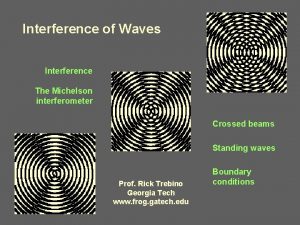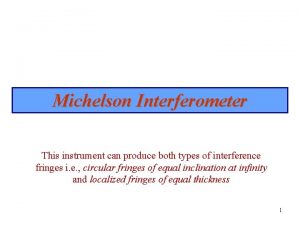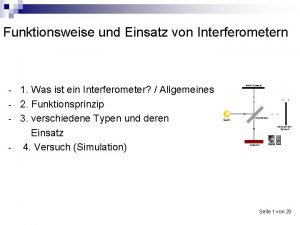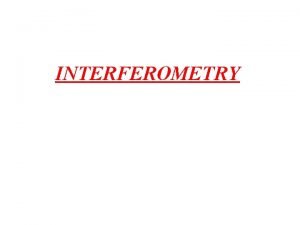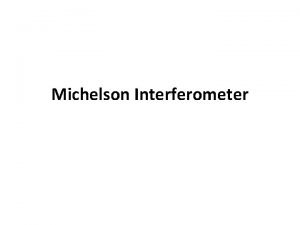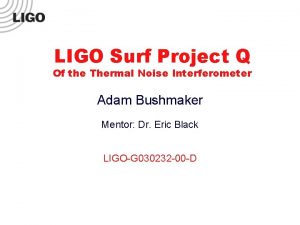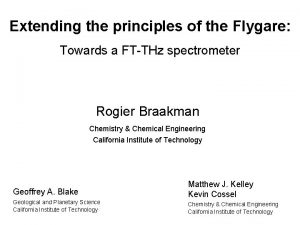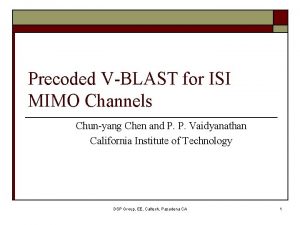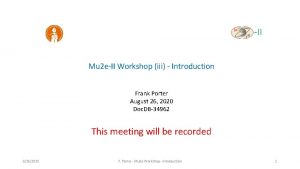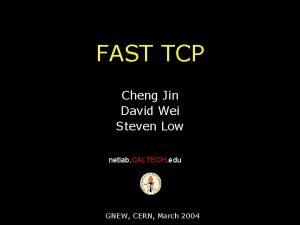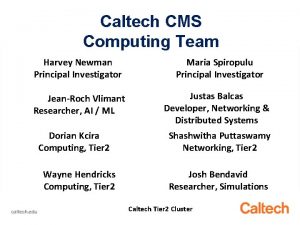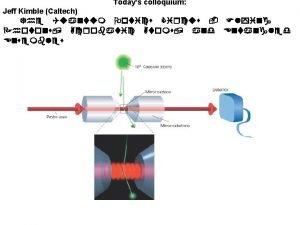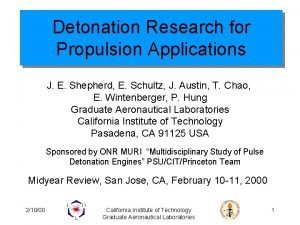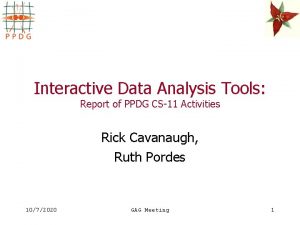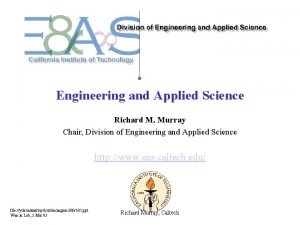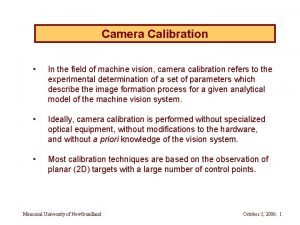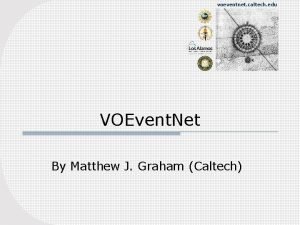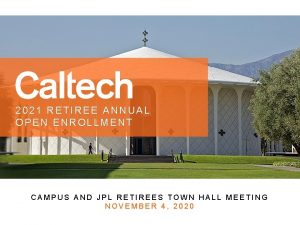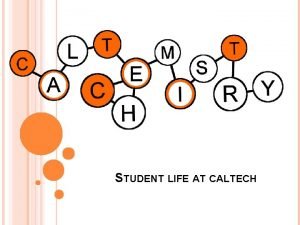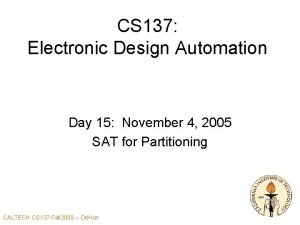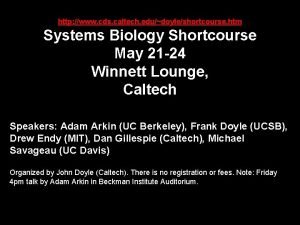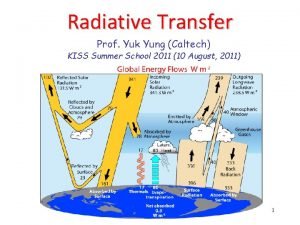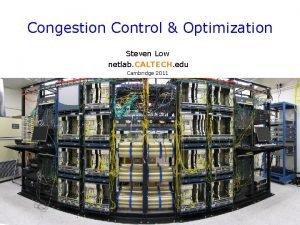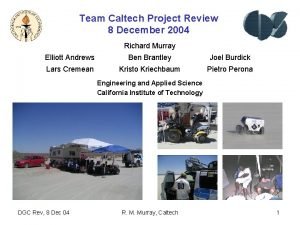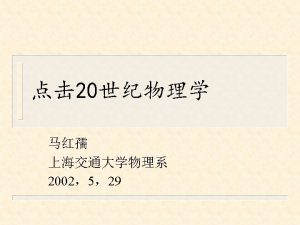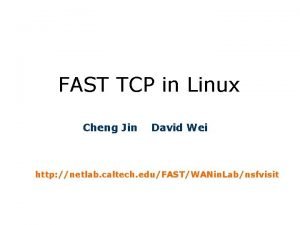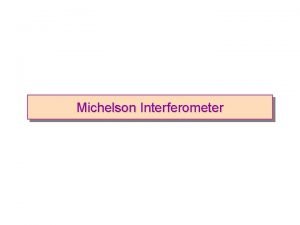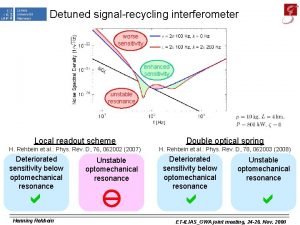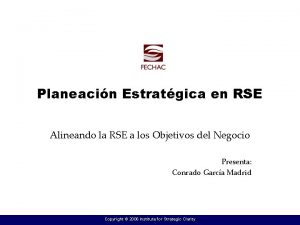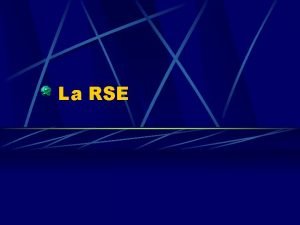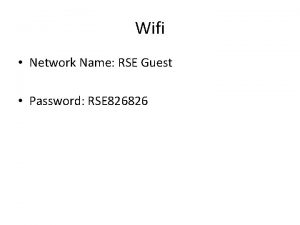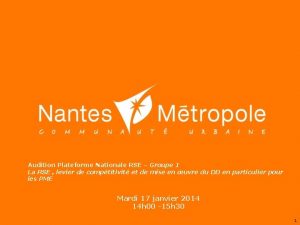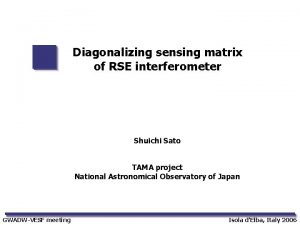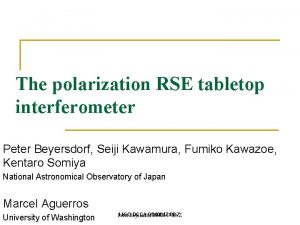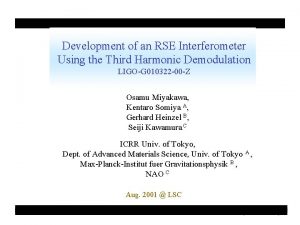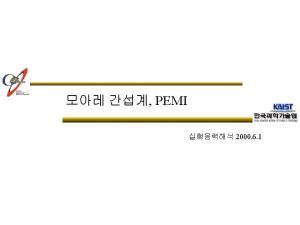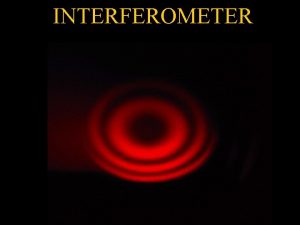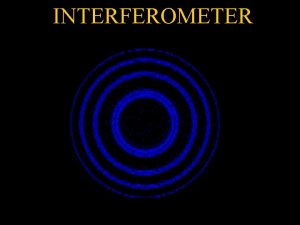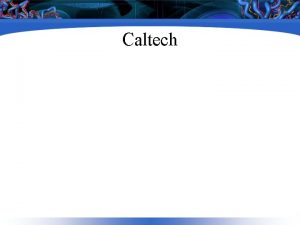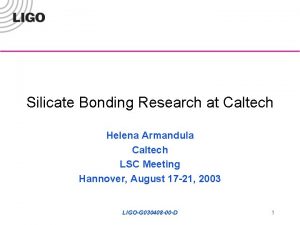The Caltech 40 m Prototype Detuned RSE Interferometer




































































- Slides: 68

The Caltech 40 m Prototype Detuned RSE Interferometer Robert Ward NAOJ seminar March 1, 2006 Osamu Miyakawa, Rana Adhikari, Matthew Evans, Benjamin Abbott, Rolf Bork, Daniel Busby, Hartmut Grote, Jay Heefner, Alexander Ivanov, Seiji Kawamura, Michael Smith, Robert Taylor, Monica Varvella, Stephen Vass, and Alan Weinstein Robert Ward NAOJ seminar, March 1, 2006

Michelson interferometer as a gravitational wave detector FP cavity § Gravitational wave detection using Michelson interferometer § Signal and power enhancement using Fabry-Perot cavity in each arm FP cavity Laser BS FP cavity § Power enhancement using Power Recycling Laser FP cavity PRM BS Robert Ward NAOJ seminar, March 1, 2006

FP cavity Advanced LIGO optical configuration Laser PRM Power § LIGO: Power recycled FPMI » Optical noise is limited by Standard Quantum Limit (SQL) § Adv. LIGO: GW signal enhancement using Detuned RSE » Two dips in the quantum noise due optical spring, optical resonance » Has the potential to beat the SQL QND detector » Or allows quantum noise curve to be optimized in the presence of thermal noise FP cavity BS GW signal Detuning Robert Ward NAOJ seminar, March 1, 2006

Ad. LIGO noise curve Fight the Fundamental Noise Sources: 1) Seismic 2) Thermal 3) Quantum Bench Active Seismic Isolation External Seismic Pre. Isolation Quadruple pendulum suspensions 40 kg, fused silica Test Masses 125 W Laser Robert Ward NAOJ seminar, March 1, 2006

Resonant Sideband Extraction and Signal Recycling § Resonant Sideband Extraction(RSE) » Decrease storage time of GW signal in IFO – Allows high finesse arm cavities – Low power recycling, or power recycling not required – Less thermal effects § Signal Recycling(SR) » Increase storage time of GW signal in IFO Ad. LIGO LCGT LIGO VIRGO TAMA 300 – Low finesse arm cavities, or arm cavities not required – High power recycling required, so-called dual recycling(DR) – Higher thermal effects GEO 600 Robert Ward NAOJ seminar, March 1, 2006

Caltech 40 meter prototype interferometer Objectives § Develop a lock acquisition procedure for suspended-mass detuned RSE interferometer with power recycling, preferably one that will be applicable to Advanced LIGO BS SRM PRM § Characterize and optimize optical configuration (for robust control and sensitivity) Bright Dark port § Characterize noise mechanisms port § Develop DC readout scheme § Test QND techniques X arm § Extrapolate to Ad. LIGO via simulation § Prototyping will yield crucial information about how to build and run Ad. LIGO Robert Ward Y arm NAOJ seminar, March 1, 2006 6

Pre-Stabilized Laser(PSL) and 13 m Mode Cleaner(MC) BS East Arm ITMx ITMy PSL ETMx FSS 40 m a PMC VCO C M AOM m 13 Mode Cleaner South Arm MOPA 126 Detection bench ETMy Robert Ward § § § 10 W MOPA 126 Frequency Stabilization Servo (FSS) Intensity Stabilization Servo Pre-Mode Cleaner (PMC) 13 m Mode Cleaner NAOJ seminar, March 1, 2006 rm ca vity

LIGO-I type single suspension § Each optic has five OSEMs (magnet and coil assemblies), four on the back, one on the side § § The magnet occludes light from the LED, giving position Current through the coil creates a magnetic field, allowing mirror control Robert Ward NAOJ seminar, March 1, 2006 8

40 m Sensitivity Not very likely that we’ll actually detect any gravitational waves here, but hopefully we’ll learn some things about operating interferometers, especially about the quantum noise. Bench Robert Ward NAOJ seminar, March 1, 2006

40 m DARM Optical Plant UGF The 40 m operates in a detuned RSE configuration, which gives rise to two peaks in the DARM transfer function: 1) Optical Resonance 2) Optical Spring Robert Ward NAOJ seminar, March 1, 2006

Detune Cartoon • IFO Differential Arm mode is detuned from resonance at operating point IFO DARM/CARM slope related to spring constant Carrier frequency Sideband amplitude [a. u. ] FWHM SRC fsig LSB USB DARM • IFO Common Arm mode is detuned from resonance at intial locking point frequency offset from carrier [Hz] • Responses of GW USB and GW LSB are different due to the detuning of the signal recycling cavity. Robert Ward NAOJ seminar, March 1, 2006 PRC CARM 11

Signal Extraction Scheme Carrier -f 2 -f 1 • Single demodulation • Arm information f 1 f 2 PRM • Double demodulation • Central part information § § § Arm cavity signals are extracted from beat between carrier and f 1 or f 2. Central part (Michelson, PRC, SRC) signals are extracted from beat between f 1 and f 2, not including arm cavity information. Only +f 2 sideband resonates in combined PRC+SRC Robert Ward NAOJ seminar, March 1, 2006

5 DOF for length control Signal Extraction Matrix (in-lock, DC) 40 m ETMy Phase Modulation f 1=33 MHz f 2=166 MHz Ly=38. 55 m Finesse=1235 ITMy PRM Laser ly lx lsy BS ITMx Por t Dem. Freq. L L l l ls SP f 1 1 0 -0. 001 0 0 AP f 2 0 1 0 0. 001 0 SP f 1 f 2 -0. 001 1 -0. 032 -0. 100 AP f 1 f 2 -0. 001 0. 002 0. 750 1 0. 070 PO f 1 f 2 0. 004 0. 003 0. 460 -0. 023 1 ETMx Lx =38. 55 m Finesse=1235 lsx SRM PO SP AP Robert Ward NAOJ seminar, March 1, 2006 : L =( Lx Ly) / 2 : L = Lx Ly : l =( lx ly) / 2 =2. 257 m : l = lx ly = 0. 451 m : ls=( lsx lsy) / 2 =2. 15 m

Disturbance by sidebands of sidebands Original concept Real world Carrier -f 2 -f 1 Carrier f 1 -f 2 -f 1 f 1=33 MHz f 2=166 MHz 133 MHz 199 MHz § Sidebands of sidebands are produced by two series EOMs. § Beats between carrier and f 2 +/- f 1 disturb central part. Robert Ward Port Dem. Freq. L L l l ls SP f 1 1 0 -. 001 0 0 AP f 2 0 1 0 . 001 0 SP f 1 f 2 7. 4 0 1 -. 033 -. 110 AP f 1 f 2 -0. 001 32 . 710 1 . 071 PO f 1 f 2 3. 3 1. 7 . 190 -. 035 1 NAOJ seminar, March 1, 2006

Mach-Zehnder interferometer on 40 m PSL to eliminate sidebands of sidebands Series EOMs with sidebands of sidebands f 1 Mach-Zehnder interferometer with no sidebands of sidebands PMC trans f 2 PZT EOM 2 EOM 1 EOM 2 f 1 EOM 1 Locked by internal modulation To MC PD PMC transmitted to MC Robert Ward NAOJ seminar, March 1, 2006

Real Time Digital Control System 16 k. Hz Sampling Rate Suspension controllers Fiber communication network Length Sensing and Control Interface to Operators Data Acquisition Robert Ward NAOJ seminar, March 1, 2006 • Also have an extensive slow controls network (EPICS)

Digital length sensing and control system D/A mixer Provides great flexibility to try out new control/locking schemes Easy to optimize control matrix Robert Ward NAOJ seminar, March 1, 2006 Output to suspensions A/D Feedback filters AP 166 Demodulated signal from PD D/A

Digital Controller § § § Flexibility » digital filtering » smooth signal handoff Diagnostics » arbitrary transfer functions Reconfigurability » construct new control links, servos rapidly » quickly change MIMO servo filter Optimization » can do automatic matrix diagonalization Automation Robert Ward NAOJ seminar, March 1, 2006

Automation of Routine Tasks § Using the digital control system, we use shell scripts to automate routine tasks. • Restores alignment of ETM, ITM, mis-aligns other optics, sets up loop gains and control flow, and engages lock acquisition routine. • Steers ITM to center transmitted beam on QPD, dithers input beam and ETM alignment, servos to minimize dither signal in power level. Robert Ward NAOJ seminar, March 1, 2006

Control Setting Log (conlog) • Constantly records all digital control settings (thousands of channels). • Log files accessible through a simple web interface • Useful for operators, commissioners, and data analysts. Robert Ward NAOJ seminar, March 1, 2006

40 m Goal #1: Develop a Lock Acquisition procedure for Ad. LIGO § Version 1. 0: » Basically a “Brute Force” technique » All optics are aligned, all DOFs are swinging. » Do some fast normalization, switching on/off of feedback: try to grab control without pumping too much energy into the system » Works much better with large available signals, strong actuators. » Suitability of procedure for Ad. LIGO to be extrapolated via simulation. Robert Ward NAOJ seminar, March 1, 2006

40 m Lock Acquisition part I: Off-resonant lock scheme for a single cavity Transmitted light is used as Resonant Lock Off-resonant Lock point 10 x higher finesse than LIGO Robert Ward NAOJ seminar, March 1, 2006

40 m Lock acquisition procedure (v 1. 0) Start with no DOFs controlled, all optics aligned. ITMy 166 MHz ITMx 13 m MC BS 33 MHz PRM SP 33 PO DDM SRM SP 166 SP DDM AP 166 AP DDM Robert Ward NAOJ seminar, March 1, 2006

40 m Lock acquisition procedure (v 1. 0) 1/sqrt(Tr. Y) DRMI + 2 arms with CARM offset Average wait : 3 minute (at night, with tickler) • MICH: SP 33 Q • PRC: SP 33 I • SRC PO 133 I • XARM: DC lock • YARM DC lock Less than 1% of maximum circulating power ITMy 166 MHz ITMx 13 m MC 33 MHz BS PRM T =7% SP 33 SP 166 I SP DDM Q SRM T =7% PO DDM AP 166 AP DDM Robert Ward NAOJ seminar, March 1, 2006 1/sqrt(Tr. X)

40 m Lock acquisition procedure (v 1. 0) All done by script, automatically Short DOFs -> DDM DARM -> RF signal CARM -> DC signal CARM -> Digital CM_MCL servo 1/sqrt(Tr. X)+ 1/sqrt( Tr. Y) + ITMy 166 MHz -1 DARM BS PRM SP 33 SP 166 SP DDM PO DDM SRM To DARM AP 166 AP DDM Robert Ward + ITMx 13 m MC 33 MHz CARM NAOJ seminar, March 1, 2006 AP 166 / sqrt(Tr. X+Tr. Y)

40 m Lock acquisition procedure (v 1. 0) Reduce CARM offset: script 1. Go to higher ARM power (10%) 2. Switch on AC-coupled analog CM servo, using REFL DC as error signal. 3. Switch to RF error signal (POX) at half-max power. 4. Reduce offset/increase gain of CM. -1 ITMy 166 MHz ITMx 13 m MC BS 1900 W SP 166 33 MHz PRM PO DDM SRM SP 33 SP DDM REFL To DARM AP 166 AP DDM Robert Ward DARM NAOJ seminar, March 1, 2006 AP 166 / (Tr. X+Tr. Y)

DARM Optical response with fit to Buonanno & Chen formula DARMin 1 / DARMout --------------XARMin 1 / XARMout times arm cavity pole. Yields optical response, taking out pendulum, analog & digital filtering, etc. XARM TF is understood semi-quantitatively. Offset-locked CARM also has optical spring peak, also well modeled. Anti-spring TF also well modeled. Robert Ward NAOJ seminar, March 1, 2006 27

The DARM anti-spring § § § With SRM detuned in the wrong direction, will see an antispring in DARM This is equivalent to resonating the –f 2 RF sideband in SRC. Oddly, this is also easier to lock Robert Ward NAOJ seminar, March 1, 2006

Detune Cartoon • IFO Differential Arm mode is detuned from resonance at operating point IFO DARM/CARM slope related to spring constant Carrier frequency Sideband amplitude [a. u. ] FWHM SRC fsig LSB USB DARM • IFO Common Arm mode is detuned from resonance at intial locking point frequency offset from carrier [Hz] • Responses of GW USB and GW LSB are different due to the detuning of the signal recycling cavity. Robert Ward NAOJ seminar, March 1, 2006 PRC CARM 29

Simple picture of optical spring in detuned RSE Move arms differentially, X arm longer, Y arm shorter from operating point Wrong SRM position Correct SRM position BRSE Power(W) X arm Y arm Power(W) Y arm DARM (Lx-Ly) § § § Power X arm down, Y arm up Radiation pressure X arm down, Y arm up Spring constant Negative(optical spring) Robert Ward DARM (Lx-Ly) X arm down, Y arm down X arm up, Y arm down N/A NAOJ seminar, March 1, 2006 Positive(no optical spring)

Changing the DARM quadrature 1. 2. 3. 4. 5. Lock IFO with CARM offset Handoff DARM to RF Adjust RF demodulation phase Reduce CARM offset This changes the quadrature of the signal. As we are not compensating for this by adjusting the demod phase, the shape of the response changes. Unbalanced Sideband Detection: b 2 Robert Ward NAOJ seminar, March 1, 2006 demodulation phase b 1

Changing the DARM quadrature • Squares are data, solid lines are from Optickle. • Optickle results are generated by measuring response in a single quadrature while changing the CARM offset. • This should be analogous to how the data was taken (reducing the CARM offset while always measuring with the same RF demod phase). Blackboard Robert Ward NAOJ seminar, March 1, 2006

CARM optical springs • Solid lines are from TCST • Stars are 40 m data • Max Arm Power is ~80 • Also saw CARM anti-springs, but don’t have that data Robert Ward NAOJ seminar, March 1, 2006

elationship between the CARM and DARM springs a § With the 40 m Lock Acquisition scheme, we only see a CARM spring if th • Using the DC-locking scheme for the arms, there are, prima facie, four locking points corresponding to the four possible gain combinations, but only two will acquire lock. Correct SRM position Incorrect SRM position Xarm Yarm DARM CARM + + x x + + 0 - - - 0 + - - x x + - - + x x Robert Ward NAOJ seminar, March 1, 2006 34

Will it lock? • x-axis: EY position • y-axis: signal • blue: X err • green: Y err • black: DARM • red: CARM NO modeled with FINESSE (open loop) YES Robert Ward NAOJ seminar, March 1, 2006

Compensating the resonances Compensation Filters for the two resonances associated with the signal cavity: Optical DARM CARM Robert Ward UGFs ~ 250 Hz Opto-mechanical 4 k. Hz >> UGF no compensation Ad. LIGO: 180 Hz ~ UGF 40 Hz < UGF no compensation Ad. LIGO: 70 Hz? 0 ->100 Hz ~ UGF 1 k. Hz -> 100 Hz ~ UGF Not yet coherently dynamic compensation compensated NAOJ seminar, March 1, 2006

Dynamic compensation filter for CARM servo Open loop TF of CARM Optical gain of CARM • Optical gain (normalized by transmitted arm power) shows moving peaks due to reducing CARM offset. • We have a dynamic compensative filter having nearly the same shape as optical gain except upside down. Designed using FINESSE. • Open loop transfer function has no phase delay in all CARM offset. Robert Ward NAOJ seminar, March 1, 2006

Mode healing/injuring at Dark Port Negative spring constant with optical spring Carrier power at DP is 10 x smaller Robert Ward Positive spring constant with no optical spring • Repeatable • The same alignment quality NAOJ seminar, March 1, 2006

Next steps § § § § Stable operation and noise hunting More lock acquisition schemes Modeling/E 2 E simulation for Ad. LIGO DC readout with Output Mode Cleaner Squeezed Vacuum in the Dark Port Active Alignment control with wave front sensors LF RF modulation scheme Alternatives to Mach-Zender Robert Ward NAOJ seminar, March 1, 2006

Other Lock Acquisition Schemes Alternative Locking Schemes are on the way! § Deterministic Locking: » Locking occurs in stages, with each stage having robust control » Each stage can (and should) lock on the first ‘fringe’, or be robust to fringes. » Transitions between stages are smooth and robust: example-PR-FPMI § Advantages: » Easier to diagnose problems » Should require less actuation potential – If we can lock a single arm cavity, we can lock the IFO. » No statistical characterization (i. e. , mean-time-to-lock). 40 M: 7 m. N 1. 3 kg test mass Ad. LIGO f/m = 5 Robert Ward 200 µN 40 kg test mass f/m =5 e-3 NAOJ seminar, March 1, 2006

Deterministic Locking: PRFPMI § Example Procedure to lock the PRFPMI: » Mis-align PRM, SRM » Lock ARMs with DC-signal (offset) – normalized by power in recycling cavity » Lock MICH with DC-signal (offset) – dark port power normalized recycling cavity power » Slowly re-align the PRM – Stable in this stage (power in IFO fluctuates as PRM swings, but the other optics are not disturbed as this power is normalized out) » Lock PRC with SP 33 I » Reduce MICH offset, handoff to SP 33 Q » Reduce ARM offset (not done yet) Robert Ward NAOJ seminar, March 1, 2006

e 2 e SIMULATION: 4 Om/Adv. LIGO package Real data have been used to estimate relative mirror velocity for both the arms: Vxarm= (0. 35 ± 0. 13) μm/s Tr X real data E 2 E Vyarm= (0. 26 ± 0. 13) μm/s Comparison between real data (black) and e 2 e simulated data (red) of the transmitted light for both the arms (full IFO): the mirror velocities used in E 2 E simulation are the values obtained fitting the real data Robert Ward Tr Y real data NAOJ seminar, March 1, 2006 E 2 E 42

E 2 E DARM TF to I and Q • 5 W Input • Arms controlled with POX, POY (no DARM) • no MICH control Hiro Yamomoto Robert Ward NAOJ seminar, March 1, 2006

Optickle: Frequency Domain IFO Simulation § Optickle is a new frequency domain IFO modeling tool: » Written in Matlab – Matlab allows easy integration to other modeling efforts (a frequencydomain e 2 e, like Lin. LIGO) – Easily Extensible – Uses Matlab classes for generality » Uses the methods outlined in T. Corbitt et al: “Mathematical framework for simulation of quantum fields in complex interferometers using the two-photon formalism” (LIGO-P 030071 -00 R) to calculate the IFO opto-mechanical frequency response. » Designed for concrete units (Watts, meters, Hz) Robert Ward NAOJ seminar, March 1, 2006

Optickle example: detuned FP cavity § Response of front mirror to back mirror ‘excitation’ § 1 nm detune § finesse ~ 1200 Robert Ward NAOJ seminar, March 1, 2006

Optickle Example: Ad. LIGO § § Easy to create a frequency dependent coupling matrix, useful for, e. g. , estimating the contribution of loop noise to DARM. This plot is Open Loop. Closed loop coming soon! Robert Ward NAOJ seminar, March 1, 2006

DC Readout Quantum Noise: Heterodyne vs Homodyne Quantum noise curves plotted using formulas in: A. Buonanno, Y. Chen, N. Mavalvala, “Quantum noise in laser-interferometer gravitational-wave detectors with a heterodyne readout scheme” PHYSICAL REVIEW D 67, 122005 2003 Robert Ward NAOJ seminar, March 1, 2006

What is DC Readout and how does it relate to Homodyne Detection? DC Readout is Homodyne detection, using light circulating in the interferometer as a local oscillator. Advantage: LO light has been filtered by the <1 Hz coupled cavity pole, Spatially perfectly matched to signal sidebands Disadvantage: limited ability to control homodyne phase OMC Robert Ward NAOJ seminar, March 1, 2006

RF vs DC o Phase modulate the input light o RF sidebands act as local oscillator for GW signal, after passing through (unstable) recycling cavity(ies) o GW signal is an audio frequency sideband of RF photocurrent o Mix GW signal down to near. DC o Acquire GW signal at DC with ADC Robert Ward ü Eliminate the RF sidebands at Dark Port with an Output Mode Cleaner ü Eliminate junk light at the Dark Port with Output Mode Cleaner ü Carrier light acts as a local oscillator ü GW signal is an audio frequency photocurrent ü Acquire GW signal at DC with ADC NAOJ seminar, March 1, 2006

Technical noise sensitivity Noise Source Laser frequency noise Laser amplitude noise Laser pointing noise DC readout ~10 x more sensitive Less sensitive since carrier is filtered Sensitivity identical for frequencies below ~100 Hz; both driven by technical radiation pressure 10 -100 x more sensitive above 100 Hz Carrier is filtered Sensitivity essentially the same Oscillator phase noise Robert Ward RF readout -140 d. Bc/rt. Hz at 100 Hz NAOJ seminar, March 1, 2006 NA

Making the DC local oscillator § Two components » Carrier field due to loss differences (not controllable? TCS? ) » Carrier field due to dark fringe offset (controllable) fringe » An output mode cleaner should take care of the offset rest. (RF sidebands, junk light) LIGO I GW parallel to Detuned RSE: DC offset GW signal gets fdependent phase shift in SRC β § Loss mismatch component » Average arm round trip loss: 200 ppm » Difference between arms: 50 ppm » Output power due to mismatch: 20 µW Loss mismatch § Detection angle, β » Tuned by adjusting fringe offset – Can tune from 0 -80 deg with 0 -10 pm of DARM offset – 1 m. W LO » Angle of GW is frequency dependent in detuned RSE Some linear component No slope Robert Ward NAOJ seminar, March 1, 2006

OMC Properties The Output Mode Cleaner filters the light coming out of the dark port, cleaning away the junk and transmitting the GW-signal containing TEM 00 mode of the carrier Robert Ward NAOJ seminar, March 1, 2006

Output mode cleaner, DC PD OMC: Monolithic, copper, 4 -mirror design. DCPD: Monolithic, electronics in vacuum nipple Robert Ward NAOJ seminar, March 1, 2006 53

Output Optic Chamber Existing in-vac seismically isolated optical table (OOC) to OMCR beamline Mike Smith has designed a compact, monolithic MMT, similar to our input MMT, using spherical mirrors. Pair of DC PDs with in-vac electronics on monolithic base. 4 -mirror monolithic OMC. from SRM 2 nd PZT steering mirrors and their controls are duplicates of a pair that we have already installed and commissioned for steering from IMC to main IFO (in-vac); controls are fully implemented in the ASC system (by Rolf). Similar systems can be used for “LIGO I. V”. to OMCT beamline IMCR, IMCT, and SP beamlines to AS RF beamline (roughly 1/3 of AS power) also a convenient path for autocollimator beam, for initial alignment in air Robert Ward from PSL to IMC NAOJ seminar, March 1, 2006 Piezosystem Jena PSH 5/2 SG-V, PZT tilting mirror mount with strain gauge, and associated drivers and power supplies Mike Smith

Squeezing Tests at the 40 m § Audio frequency squeezed sources now available at MIT § Time to take steps toward eventual implementation on long baseline interferometers 10 1 1 k. Hz 100 k. Hz » Homodyne detection along with ifo signals and noise couplings – Most interesting and relevant for complex ifo configurations » A few interferometer configurations possible – narrow- or broadband RSE, DRMI, FPMI » Noise coupling studies possible » LIGO-like control systems for eventually porting squeezing technology to long baseline ifos Robert Ward NAOJ seminar, March 1, 2006

Interface to ongoing 40 m experiments Robert Ward NAOJ seminar, March 1, 2006 56

Possible Squeezing layout Robert Ward NAOJ seminar, March 1, 2006

Exploring alternatives to the Mach-Zender § With two EOMs in series to generate PM sidebands at f 1 and f 2, get “sidebands on sidebands” at f 1 ± f 2 § We use MZ to generate sidebands in parallel f 1 Robert Ward f 2 NAOJ seminar, March 1, 2006

Synthesize MZ? § The MZ adds complexity and noise. Can we do it with one EOM? § The PM waveform that must be input to a single EOM to produce f 1 and f 2 with no f 1 ± f 2 : § required waveform: Robert Ward Synthesized: NAOJ seminar, March 1, 2006

The synthesized waveform does the job! § BUT it can’t be done with pure PM; it involves complex coefficients (AM). Robert Ward NAOJ seminar, March 1, 2006

Can it be done with pure PM? § Using only real sines and cosines: § Doesn't work: -4 f and -6 f are suppressed, but +4 f and +6 f are not. Robert Ward NAOJ seminar, March 1, 2006

DRMI lock using double demodulation with unbalanced RF sideband in SRC Carrier 33 MHz 166 MHz ITMy BS ITMx Unbalanced 166 MHz PRM DDM PD 33 MHz Belongs to next carrier SRM OSA DDM PD OSA Robert Ward NAOJ seminar, March 1, 2006 Belongs to next carrier

L- optical gain with RSE peak Measured in June 2005 • Optical gain of L- loop DARM_IN 1/DARM_OUT, divided by pendulum transfer function Design RSE peak ~ 4 k. Hz • No offset on L- loop • 150 pm offset on L+ loop • Optical resonance of detuned RSE can be seen around the design RSE peak of 4 k. Hz. • Q of this peak is about 6. Robert Ward NAOJ seminar, March 1, 2006

§ Double Demodulation used for l+, l-, and ls § Demodulation phases optimized to suppress DC and to maximize desired signal Robert Ward Demodulation Phase of f 2 Double Demodulation NAOJ seminar, March 1, 2006 Locking point 64

Laser Intensity Noise § calculated using rsenoise § 10 pm DARM offset for DC § 1 e-13 m residual LRF: noise sidebands of RF sidebands beat against residual length offset DC: dark port power proportional to input power Radiation pressure effects not included Robert Ward NAOJ seminar, March 1, 2006

Laser Frequency Noise § calculated using rsenoise § 10 pm DARM offset for DC § 1 e-13 m residual LRF: frequency noise sidebands of RF sidebands beat against static carrier contrast defect DC: Arm cavity pole imbalance couples carrier frequency noise to dark port Radiation pressure effects not included Robert Ward NAOJ seminar, March 1, 2006

How much power inside arm? Design Cavity reflectivity PRM reflectivity Loss in PRC Achievable PRG Coupling Input power Power in one arm Optical spring Robert Ward Measured(estimated) 93% 85%(X arm 84%, Yarm 86%) 93% 92. 2% 0% 2. 3% 14. 5 5. 0 Over coupled Under coupled 0. 1 W 1 W 560 W 1900 W 23 Hz 41 Hz NAOJ seminar, March 1, 2006

GW readout, Systems l DC rather than RF for GW sensing » Requires Output Mode-Cleaner to reject RF » Offset ~ 1 picometer from dark fringe can tune from 0 to 80 deg with 0 -100 m. W of fringe offset power Noise Source Laser frequency noise Laser amplitude noise RF readout DC readout ~10 x more sensitive Less sensitive since carrier is filtered Sensitivity identical for frequencies below ~100 Hz; both driven by technical radiation pressure 10 -100 x more sensitive above 100 Hz Carrier is filtered Laser pointing noise Sensitivity essentially the same Oscillator phase noise Robert Ward -140 d. Bc/rt. Hz at NA 100 Hz NAOJ seminar, March 1, 2006 fringe offset β Loss mismatch
 Prototype reddit
Prototype reddit Design prototype test reddit
Design prototype test reddit Rse nrse
Rse nrse Statutory rse
Statutory rse Evaluation rse
Evaluation rse What is rse
What is rse What is rse
What is rse Magdalena ridge observatory interferometer
Magdalena ridge observatory interferometer Interferometer oberflächenmessung
Interferometer oberflächenmessung What is the principle of michelson interferometer
What is the principle of michelson interferometer Laser interferometer space antenna
Laser interferometer space antenna Mach-zehnder-interferometer leifi
Mach-zehnder-interferometer leifi Michelson interferometer formula
Michelson interferometer formula Michelson interferometer formula
Michelson interferometer formula Weißlichtinterferometer funktionsweise
Weißlichtinterferometer funktionsweise Npl flatness interferometer
Npl flatness interferometer Cara kerja interferometer michelson
Cara kerja interferometer michelson Shreya anand caltech
Shreya anand caltech My project q
My project q Frank rice caltech
Frank rice caltech Lei chen caltech
Lei chen caltech Frank porter caltech
Frank porter caltech David mayo caltech
David mayo caltech David jin caltech
David jin caltech Harvey newman caltech
Harvey newman caltech Jeff kimble caltech
Jeff kimble caltech Joe shepherd caltech
Joe shepherd caltech Cs11 team
Cs11 team Richard murray caltech
Richard murray caltech Family feud presented by
Family feud presented by Machine vision calibration
Machine vision calibration Matthew graham caltech
Matthew graham caltech 8776441774
8776441774 Caltech student housing
Caltech student housing Caltech
Caltech Caltech cds
Caltech cds Yuk yung caltech
Yuk yung caltech Arpanet
Arpanet Tqfr caltech
Tqfr caltech Richard murray caltech
Richard murray caltech Christina cohen caltech
Christina cohen caltech Richard feynman caltech
Richard feynman caltech Richard ellis caltech
Richard ellis caltech Dummynet
Dummynet Vẽ hình chiếu vuông góc của vật thể sau
Vẽ hình chiếu vuông góc của vật thể sau Công thức tính thế năng
Công thức tính thế năng Tỉ lệ cơ thể trẻ em
Tỉ lệ cơ thể trẻ em Thế nào là mạng điện lắp đặt kiểu nổi
Thế nào là mạng điện lắp đặt kiểu nổi Hát kết hợp bộ gõ cơ thể
Hát kết hợp bộ gõ cơ thể Lời thề hippocrates
Lời thề hippocrates Vẽ hình chiếu đứng bằng cạnh của vật thể
Vẽ hình chiếu đứng bằng cạnh của vật thể Quá trình desamine hóa có thể tạo ra
Quá trình desamine hóa có thể tạo ra Phản ứng thế ankan
Phản ứng thế ankan Các môn thể thao bắt đầu bằng tiếng chạy
Các môn thể thao bắt đầu bằng tiếng chạy Khi nào hổ con có thể sống độc lập
Khi nào hổ con có thể sống độc lập Dot
Dot điện thế nghỉ
điện thế nghỉ Biện pháp chống mỏi cơ
Biện pháp chống mỏi cơ Trời xanh đây là của chúng ta thể thơ
Trời xanh đây là của chúng ta thể thơ Gấu đi như thế nào
Gấu đi như thế nào Thiếu nhi thế giới liên hoan
Thiếu nhi thế giới liên hoan Vẽ hình chiếu vuông góc của vật thể sau
Vẽ hình chiếu vuông góc của vật thể sau Một số thể thơ truyền thống
Một số thể thơ truyền thống Các châu lục và đại dương trên thế giới
Các châu lục và đại dương trên thế giới Thế nào là hệ số cao nhất
Thế nào là hệ số cao nhất Hệ hô hấp
Hệ hô hấp Số nguyên tố là số gì
Số nguyên tố là số gì Tư thế ngồi viết
Tư thế ngồi viết
